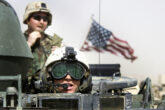March 17, 2021
Simulating War: Three Enduring Lessons from the Louisiana Maneuvers
On Monday, Sept. 15, 1941, a special kind of war was declared. As a tropical storm sent torrential rains throughout the Gulf of Mexico, swelling rivers and caking the ground in mud, 472,000 troops bivouacked between Shreveport and Lake Charles, Louisiana, for the largest (simulated) force-on-force battle in U.S. history. The opposing “red” force’s mission: invade “blue” territory and destroy the enemy concentrated near Lake Charles. Over the course of five days, a small, mobile red force and a numerically superior blue force maneuvered over 3,400 square miles, engaging in a series of tank and antitank skirmishes from the Red River to the Leesville-Many highway. At 15:30 on Friday, just as the red force’s eastern flank at Natchitoches started to crumble, the exercise was halted. Blue had seemingly prevailed.
Sept. 15 was the start of the Louisiana Maneuvers, a series of four exercises that took place over two separate venues — the Louisiana-Texas border and the Carolinas — with each spanning vast, scarcely populated areas of dense forests, uncharted swamps, and river crossings. The maneuvers can be heralded as a logistical achievement: At no other time has there been such a concentration of man and materiel on U.S. soil. However, their true worth was as a “combat college for troop leading” and as a field laboratory to test and train for emerging operational concepts. Indeed, notwithstanding some adjudicatory, training, and bureaucratic limitations, the mass exercises played a pivotal role in confirming the necessity of deploying tanks alongside infantry as a combined arms force. Anti-tank guns were verified as an effective countermeasure to armored vehicles. Air-ground integration, despite an initial Army Air Corps bias towards high-altitude precision daylight bombardment, was shown to have value. Perhaps most importantly, the Louisiana Maneuvers confirmed — to Americans, allies, and adversaries alike — that a ragtag group of “civilians in khaki pants” had been molded over the previous two years into a fighting army. While not a panacea, the maneuvers, in short, were the denouement of the U.S. Army’s pre-war mobilization.
The Louisiana Maneuvers — in their scale, scope, and sophistication — can provide contemporary defense planners with a number of valuable and enduring insights.
From the meticulous drills or “bloodless battles” of ancient Roman legionaries to the tabletop Kriegsspiel of Georg von Reisswitz and the more recent use of distributed, virtual, and constructive training architectures, the act of simulating war — whether through maneuvers, exercises, or wargames — has long constituted an invaluable means of training, experimentation, and signaling. In the absence of combat, simulations like the Louisiana Maneuvers can root out weaknesses, refine concepts and technologies, and acclimatize troops to the complex and varied physical realities of the battlefield. They can also allow users to transcend their current realities, ideally by helping them to question and assess those “known unknowns” (and potentially those wicked “unknown unknowns”) that may radically alter the future battlespace. For these reasons, simulation has been touted as a key avenue to imagine and prepare for the contours of future conflict.
Read the full article from War on the Rocks.
More from CNAS
-
Defense / Technology & National Security
What to Expect from Military AI in 2030As the US military races to harness artificial intelligence, experts say the biggest AI breakthroughs may not come from “killer robots” or autonomous war machines, but from al...
By Josh Wallin
-
Defense / Indo-Pacific Security / Technology & National Security
To Compete with China on Military AI, U.S. Should Set the StandardsThe United States has an opportunity to lead in global norms and standards for military AI at a critical moment, when the foundations laid today could shape how militaries use...
By Jacob Stokes, Paul Scharre & Josh Wallin
-
Defense / Energy, Economics & Security / Technology & National Security
The Outlook CEO Perspectives on Risk, Resilience and ReturnsJoin David Schwimmer and Richard Fontaine, CEO of the Center for New American Security, as they explore the current national security landscape and its impacts on global econo...
By Richard Fontaine
-
Are We Ready? | America’s Next Battlefield, with Thomas Shugart
Thomas Shugart, adjunct senior fellow at CNAS, sits down with James M. Lindsay to discuss how the tools and tactics of warfare have changed in the past decade and whether the ...
By Tom Shugart




